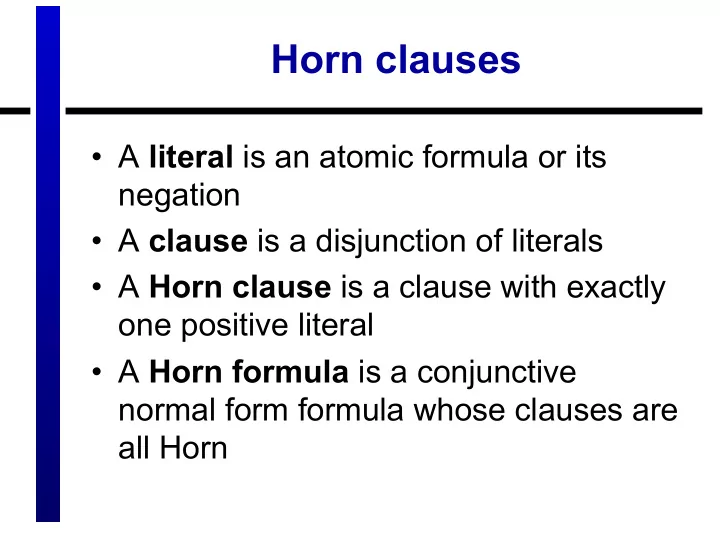

Horn clauses • A literal is an atomic formula or its negation • A clause is a disjunction of literals • A Horn clause is a clause with exactly one positive literal • A Horn formula is a conjunctive normal form formula whose clauses are all Horn
Example c:- a, b. • Prolog: a. b. • Horn formula: [c ∨ ¬a ∨ ¬ b] ∧ a ∧ b [c, ¬a, ¬ b] [a] [b]
Example • Horn formula: [c, ¬a, ¬b] [a] [b] • Let us attempt to prove c by contradiction • Hence, the goal clause is ¬c [c,¬a,¬ b] [a] [b] [¬c] • By resolution we obtain the empty clause, and hence proof c
Resolution • Resolution is a single inference rule • It takes two clauses, and produces one new clause • The new clause is implied by the two old clauses – The two old clauses need to have complementary literals – The new clause contains all the literals of both old clauses except the complementary ones • Terminates when the empty clause is produced, i.e., a proof has been found
Resolution example [c,¬a,¬b] [a] [b] [¬c]
Resolution example [c,¬a,¬b] [a] [b] [¬c]
Resolution example [c,¬a,¬b] [a] [b] [¬c] [c,¬b] [b] [¬c]
Resolution example [c,¬a,¬b] [a] [b] [¬c] [c,¬b] [b] [¬c]
Resolution example [c,¬a,¬b] [a] [b] [¬c] [c,¬b] [b] [¬c] [c] [¬c]
Resolution example [c,¬a,¬b] [a] [b] [¬c] [c,¬b] [b] [¬c] [c] [¬c]
Resolution example [c,¬a,¬b] [a] [b] [¬c] [c,¬b] [b] [¬c] [c] [¬c] []
Why Horn clauses? • Resolution of two Horn clauses always results in a Horn clause • Resolution of a goal clause and a definite clause is always a goal clause • Horn clauses have better computational properties than normal clauses • Prolog is based on computing with Horn clauses
Alfred Horn • The name Horn clause comes from Alfred Horn , who discovered the significance of such clauses
Recommend
More recommend